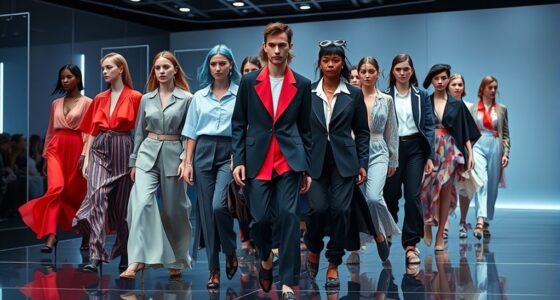Fashion weeks showcase designers’ latest collections to buyers, media, and fans across global cities like Paris and Lagos. During these events, you’ll see new trends, innovative designs, and a growing focus on sustainability with eco-friendly fabrics. Emerging designers gain recognition, and events often include digital presentations for wider reach. If you want to discover how these shows influence industry standards and inspire future fashion, keep exploring what happens behind the scenes.
Key Takeaways
- Fashion weeks showcase designers’ latest collections to industry buyers, media, and enthusiasts, setting upcoming trends and industry directions.
- They highlight sustainability by emphasizing eco-friendly fabrics and responsible design practices across collections.
- Emerging designers participate to gain recognition, introduce innovation, and diversify the fashion industry’s creative landscape.
- Preparation involves months of planning, sustainable fabric selection, and designing runway shows that often tell social or cultural stories.
- Events now include digital presentations, take place worldwide—like Paris and Lagos—reflecting global diversity and evolving industry standards.

Fashion weeks are the industry’s biggest events where designers showcase their latest collections to buyers, media, and enthusiasts. These events set the tone for upcoming trends and offer a glimpse into the future of fashion. As you attend or follow along, you’ll notice that more designers are emphasizing sustainable fabrics, reflecting a shift toward eco-conscious practices. This focus on sustainability isn’t just a trend; it’s becoming a core part of the industry’s evolution. From organic cotton to recycled fibers, designers are choosing materials that reduce environmental impact while still delivering high-quality, stylish pieces. You’ll also see emerging designers making a splash during fashion weeks. These fresh talents bring innovative ideas and new perspectives, often challenging traditional notions of fashion. Their presence injects energy into the runway shows and highlights how the industry is expanding beyond established labels. For many, fashion weeks serve as a launchpad for these emerging designers to gain recognition and attract buyers enthusiastic to discover the next big thing. The process begins months in advance, as designers prepare their collections and plan their shows. They select fabrics, often prioritizing sustainable options to align with current consumer values. The design process involves sketching, draping, and fitting, with many designers pushing boundaries and experimenting with new techniques. As the runway date approaches, they refine their collections, ensuring each piece communicates their vision clearly. When it’s time for the show, models walk the runway wearing pieces that tell a story, often inspired by current social issues or cultural themes. Sustainable fabrics are prominently featured, demonstrating a commitment to responsible fashion. During the show, the audience—comprising buyers, journalists, influencers, and other industry insiders—evaluates the collection’s viability for retail and its cultural relevance. For emerging designers, this moment is vital; it’s their chance to make a lasting impression and secure deals that can launch their careers. Many fashion weeks now incorporate presentations and digital showcases, making it easier for a global audience to engage with new designers and innovative collections. Whether in Paris, Lagos, or New York, each fashion week is a celebration of creativity, diversity, and progress. As you follow along, keep an eye out for how sustainable fabrics and emerging designers shape the dialogue. These elements are not only transforming the runway but also influencing consumer choices and industry standards. Recognizing the importance of color accuracy and how it impacts visual storytelling is vital for understanding the full scope of fashion presentation. Fundamentally, fashion weeks are more than just glamorous events—they reflect the evolving values of the industry and pave the way for a more responsible and inclusive future.
Frequently Asked Questions
How Do Designers Get Selected to Showcase Their Collections?
You get selected for a fashion week by actively engaging in fashion industry networking and developing a strong designer portfolio. Show your unique vision through your work, and build relationships with organizers, agents, and other industry insiders. Your portfolio should showcase your best designs and creativity. When you network effectively and present a compelling collection, you’re more likely to catch the attention of event organizers and secure a spot on the runway.
What Is the Difference Between a Fashion Show and a Presentation?
Imagine a stage where stories unfold. A fashion show is like a lively play with models strutting down the runway, embodying the designer’s vision, often showcasing model diversity and using runway technology to enhance the spectacle. In contrast, a presentation is a quiet art gallery, where collections are displayed more intimately, allowing viewers to examine details. Both serve as platforms to highlight creativity, but one commands attention while the other invites reflection.
How Do Fashion Weeks Impact Global Fashion Trends?
Fashion weeks shape global trends by showcasing innovative designs that influence mainstream fashion. You’re often inspired by cultural influences displayed on runways, which introduce diverse styles worldwide. Additionally, the push for sustainable fashion during these events encourages brands to adopt eco-friendly practices. As a result, you see a shift toward more responsible, culturally rich, and trendsetting fashion choices, making fashion weeks pivotal in setting the tone for upcoming seasons.
Who Are the Key Stakeholders Involved Behind the Scenes?
Imagine a well-orchestrated symphony where designers, models, and organizers work behind the scenes. You’ve got models collaborating to bring runway visions alive, media coverage capturing every moment, and buyers selecting new collections. Fabric suppliers, stylists, and photographers also play essential roles, ensuring everything runs smoothly. These key stakeholders create a dynamic network, turning a simple event into a global spectacle that influences trends and captures the world’s attention.
What Are the Costs Associated With Participating in Fashion Weeks?
When you participate in fashion weeks, you face a significant cost breakdown, including venue fees, production expenses, and models’ fees. Sponsorship funding can help offset these costs, but you’ll still need to budget for marketing, invitations, and styling. Be prepared for travel and accommodation expenses as well. Understanding these costs upfront allows you to plan effectively and seek sponsorships or partnerships to support your runway debut.
Conclusion
So, now you know the secret behind those glamorous runway shows—it’s not just about pretty clothes, but a global game of who can outshine who. Whether in Paris or Lagos, fashion weeks are basically the Olympics of style, with more drama than a soap opera. Next time you watch from your couch, remember: behind every stunning look is a whirlwind of deadlines, politics, and a dash of chaos. Who knew fashion was this wild?







